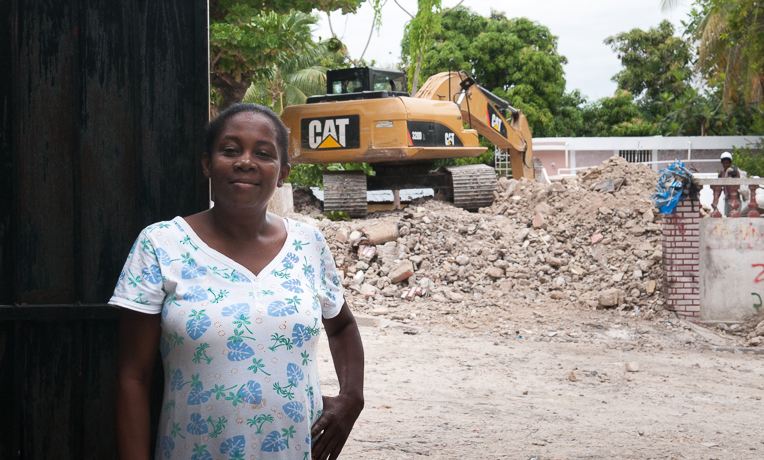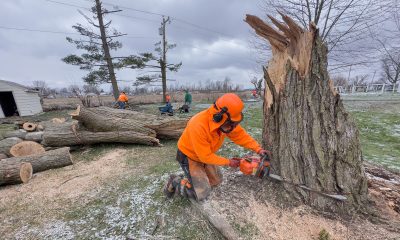Four years ago, the Haiti earthquake left Douaren Nully trapped underneath her home. She survived, but couldn’t afford to clear away the rubble and start over. The day our team arrived to help, she said it felt like being rescued again.
The rumble of the bulldozer and beeps of the reversing dump truck drowned out the chatter of bystanders watching what’s left of Douaren Nully’s house getting cleared away.
Help Haitians Recover from the EarthquakeChildren in school uniforms joined the crowd. Neighbors gathered in twos and threes. Mayor’s office representatives observed from a white pickup truck.Suddenly, excitement broke out from the top of the rubble pile. A piece of rebar had emerged. Whoever won ownership would promptly sell it on the street.
Four years have passed since the horrific Haiti earthquake on January 12, 2010, but the rubble of Douaren’s house on this corner in Carrefour hadn’t moved until now.
Survivors still easily recall what they saw, heard, and felt during the monstrous disaster. More than 300,000 lost their lives according to the Haitian government, and more than 100,000 became homeless in a matter of seconds. Here in Carrefour, a large residential section outside Port-au-Prince, the quake damaged 40 to 50 percent of homes.
After the shaking stopped on that fateful day, Douaren lay trapped underneath the house. But thankfully, she was pulled to safety without any major injuries—unlike so many of her fellow Haitians.
“When they came and pulled me out, I felt delivered,” she said.
Peering out from behind the large gate of a neighbor’s house across the street, Douaren looked at the bulldozer working high atop the rubble of her former home. It brought up the trauma of the earthquake. But with each heavy load being cleared away, it also gave her a sense of relief similar to when the rescuers came.
“Seeing this happen here now is like feeling that same deliverance all over again,” she said.
Numerous homeowners like Douaren haven’t been able to move on for four years now because they cannot afford the expense of having the remains of their houses torn down and the sites cleared. The average cost of $3,000-$5,000 USD is an unfeasible amount for many. Thus, the fractured homes—the reminders of what used to be and all that was lost—sit abandoned.

Jean Mary Metéllus has been living in tent since the earthquake. Samaritan’s Purse recently cleared his property, which was covered with obstructing debris. Jean is a Christian who desires to not only rebuild build his house, but also a school on his property. He is a teacher and dreams of a good school for the children of Carrefour.
Immediately after the earthquake, Samaritan’s Purse sent heavy equipment to Haiti, including an excavator, bulldozer, front-end loader, and dump trucks. We prioritized clearing sites for schools, churches, hospitals, and orphanages and have since moved on to residential areas, focusing on towns close to the earthquake’s epicenter.
Our partnership with the local mayor’s office helps provide referrals for the program. In one month alone, Samaritan’s Purse worked with 20 homeowners in Carrefour to clear their sites and give them the opportunity to rebuild.
For people like Douaren, receiving this free service is truly being delivered from a burden they did not know how to bear.
“While I am watching this happen, it reminds me of the earthquake, but it also gives me hope,” she said. “I see life in the chance of rebuilding now.”
In a couple of hours, our demolition and reconstruction team would finish work that may have taken weeks to complete by hand. Families often begin rebuilding their houses within the week that the rubble is removed.
When possible, we place the rubble in roads, and the bulldozer is used to make them smooth and drivable. This improved infrastructure helps foster commerce and provides better access to hospitals, schools, and churches for remote communities.
Since our Haiti response began, we have successfully removed more than 141,800 cubic meters of rubble, prepped more than 350 sites for reconstruction, and rebuilt approximately 65 kilometers of road.
Samaritan’s Purse staff show the love of Christ to homeowners and those involved with the demolition and construction projects. James said they get to know them as much as they can—sharing verses and giving them a Bible before they leave.

Samaritan’s Purse rubble removal teams have removed over 141,800 cubic meters of rubble and prepped more than 350 sites for reconstruction.
Douaren is a Christian. She said watching Samaritan’s Purse come in the name of Jesus was an example to her of faith in God.
When asked what kind of spiritual impact the last four years have had on her personally, she talked about how the Bible says disasters and other hardships will happen, and this experience has just been further proof that Christ is coming back.
“It only grows my faith stronger,” she said.
By late afternoon, the crowd on Douaren’s street corner had thinned. Children resumed their journeys home. Staff wrapped up for the day. The last dump truck disappeared down the road. The motionless bulldozer now sat atop a smaller pile of rubble, which would be completely cleared away the following morning.
Douaren withdrew behind her neighbor’s gate as quietly as she had appeared—an unspoken goodbye to the remains of what once had been a home, then a trap, and finally today, a symbol of hope.





